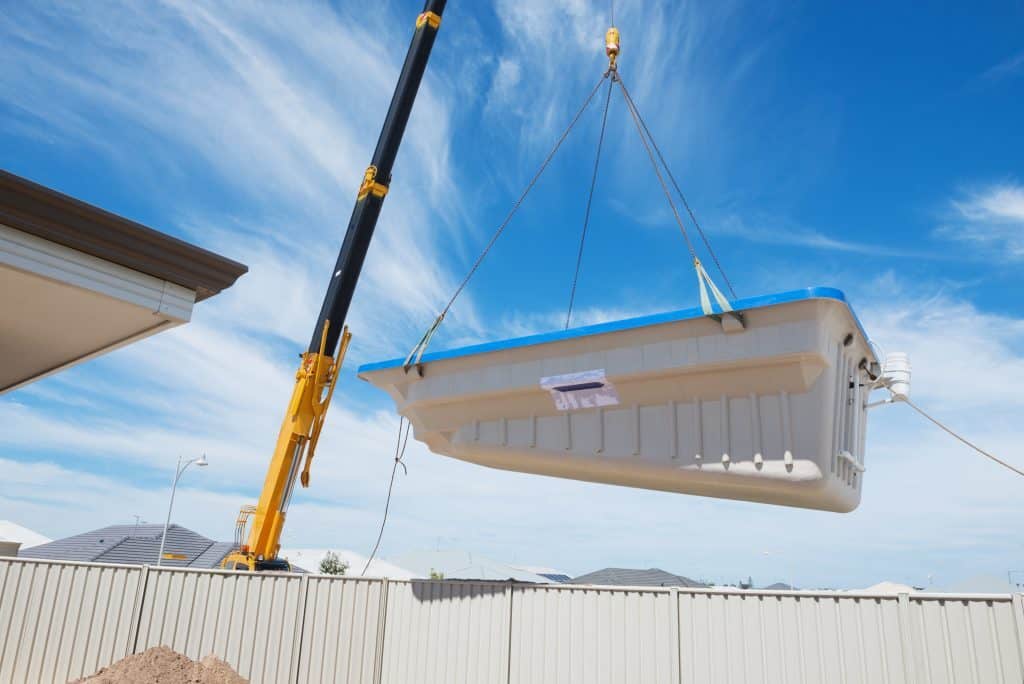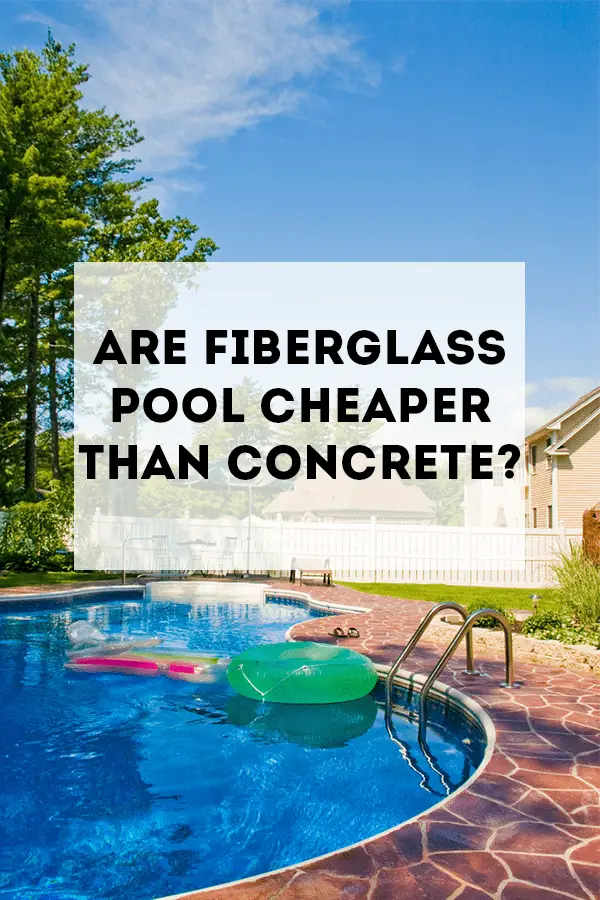
For us to understand this topic one have to understand what the fibreglass pool and concrete pool entails.
Are Fiberglass Pools Cheaper Than Concrete? Not really. Cost is about the same. On average, most fiberglass pool projects cost $45,000–$85,000. Concrete pools run in the same range as well. This includes both manufacturing and installation. Extensive retaining walls, water features, or other special additions add more to that initial price.
In this article we will explain what exactly a fiberglass pool is and its pros and cons. Keep reading to find out what the pros and cons are of a fiberglass pool.
What is a Fiberglass Pool ?
The pool shell typically ends up about ⅜ inches thick. Compare this to a concrete pool, which is 5-6 inches thick including the rebar, and to a vinyl liner pool, for which the wall panels are 4 inches thick (with the liner itself measured in negligible mils).The fibreglass pool consists of different fiberglass material mended together.The following are the materials of fibreglass pool.
The Mold
Fiberglass pools are constructed from a mold in a factory, which is why you have fewer options to customize the size and shape.
What you should ask your manufacturer about your pool mold:
1. Is the mold true and level?
2. Is the mold reinforced with steel?
3. Does the mold have a smooth, maintained finish?
The Gelcoat
The inside finish is what you see when the pool is in the ground for you to swim in. It’s applied as a gel and then hardens through polymerization (chemical bonding that strengthens it). For obvious reasons, it’s called a gelcoat. It’s super smooth and durable, and it’s algae-resistant, which is awesome for you in long-term maintenance.
The Resin
Every time we apply chopped fiberglass, we mix and apply it with either vinyl ester resin or polyester resin. (That’s resin pronounced reh-zin, as opposed to rosin pronounced rah-zin, which you use on a violin bow. Not the same thing. I checked.) The resin works as an adhesive so that the fiberglass sticks to itself and to the surrounding layers of the pool shell. The resin is the glue to the fiberglass’s paper. When mixed and applied together, they keep the correct shape with proper support.
Vinyl ester resin is what we use with the first layer of chopped fiberglass
Polyester resin is what we use with the other layers of chopped fiberglass. It’s semipermeable, and it mixes with any water that gets into it. With 100% vinyl ester resin as the first layer, no water will pass through to the polyester resin and create bubbles (blisters) in the gel coat.
The Two Stages of the Process
The process for a fiberglass pool involves two separate stages: manufacturing and installation.
Unlike concrete and vinyl liner pools, which are constructed as they are installed, fiberglass pools are actually made in a factory beforehand. The pool shell is then transported to the site and installed there in only a few weeks.
This is why the installation process is so short—most of the work is done before you even see the builders.
The Quality Check
We look for any cracks or inconsistencies in the fiberglass. While each manufacturer’s process may differ slightly, make sure they quality check the pool shell.
The builder should also weigh the pool shell to make sure it falls within an acceptable range (about 5% of the design specifications). A pool that falls outside that range may have insufficient or faulty material.You can ask for a dig sheet (the design specs) and compare the weight listed there to the weight logged on the side of your pool.
How Are Fiberglass Pools Made?
The short answer: very carefully.
Since the pool is built in the factory, you won’t see this part. Still, you should interview potential manufacturers to be sure they have a solid procedure, experienced builders , and customers you can talk to .
This is the manufacturing process River Pools uses:
1. Spray the gelcoat onto the mold.
2. Apply chopped fiberglass with vinyl ester resin.
3. Apply chopped fiberglass with polyester resin.
4. Apply woven roving at stress points for additional strength.
5. Apply structural honeycomb materials to support the side walls.
6. Apply the final layer of fiberglass with polyester resin.
7. Cure in the mold.
8. Remove the pool shell from the mold.
9. Trim the excess fiberglass.
10. Quality check the pool shell.
How are Fiberglass Pools Installed?
Most of the time, pool shell manufacturers work separately from the people who install that pool. In this case, you’ll want to interview the installer in addition to the manufacturer to verify their experience and process and ask for customer references .
Due to information gathered from a manufacturer and installer company, so we’re able to provide a seamless pool project experience.
This is the process for installing fiberglass pool:
1. Excavate the soil.
2. Set and level the pool.
3. Install the pool’s plumbing and filter system.
4. Backfill the pool shell.
5. Install the coping and patio.
6. Install the pool fence.
The installation process takes only a few weeks, so you can enjoy your pool all summer long rather than staring sadly at your torn-up yard for months.
What are the Pros and Cons of a Fiberglass Pool?
We advocate fiberglass pools because they’re a great long-term fit for many situations, but they do have their downsides. To get a better idea of whether a fiberglass pool is for you, flip through the pros and cons listed here.
Fiberglass Pool Advantages
- Fast installation
- Durable
- Low maintenance
- Low lifetime cost
- Attractive
- Compatible with salt water systems
- Fast installation
The total process to install a typical fiberglass pool usually takes three to six weeks. For comparison, a concrete pool installation can take three to six months.
This speed means less stress in your life. You can enjoy your new pool without worrying about and managing crews in your backyard for months on end.
Durable
Fiberglass is strong enough that you don’t have to worry about puncturing the gelcoat or cracking the structure through everyday use. Your dogs can play in the pool with you, no problem.
The inside finish is user-friendly and never needs to be refinished if it’s made correctly.
Low Maintenance
The
The fiberglass also doesn’t affect the water chemistry, so you don’t have to add
Low Lifetime Cost
Fiberglass pools require less electricity and fewer chemicals for maintenance—this not only saves you that time and effort, but it also cuts down your costs.
You don’t have to refinish the fiberglass or replace a liner.
Over a 10-year period, you’d spend less than $4,000 on upkeep, as compared to almost $12,000 for a vinyl liner pool or $28,000 for a concrete pool.
Attractive
Decades ago, when fiberglass pools first came out, they looked simple and (am I allowed to say this?) kind of ugly. Now, though, you can customize your pool to any aesthetic with colored finishes, spas, ceramic tile, tanning ledges, water features, and awesome lights.
When you install a fence around the pool, you can go as fancy as you want as long as it meets safety regulations.
Compatible with Salt Water Systems
The salt from salt-water chlorinators wears away at concrete and at metal (such as metal wall panels and coping on vinyl liner pools). With fiberglass, you can enjoy high-quality water with low maintenance .
Fiberglass Pool Disadvantages
- Limited options for size and shape
- Initial cost higher than a vinyl liner pool
- Limited options
Fiberglass pools typically run up to 16 feet wide, 40 feet long, and 8.5 feet deep. Because they’re created from pre-designed molds, they have fewer options for shapes and sizes. The manufacturer also has to transport the pool shell to the installation site, so highway restrictions apply.
Despite the limited customization for the basic designs, plenty of features can be
Initial Cost Higher Than a Vinyl Liner Pool
On average, most fiberglass pool projects cost $45,000–$85,000. This includes both manufacturing and installation. Extensive retaining walls, water features, or other special additions add more to that initial price.
However, fiberglass pools have the lowest long-term cost of ownership, compared to concrete or vinyl liner pools. Over 10 years, the maintenance and upkeep would only cost you about $3,750—as opposed to $11,500 (vinyl liner) or $27,400 (concrete).
What is Concrete Pool?
Cement is actually a component of concrete, not the same thing, even though we tend to use the words interchangeably. Concrete is a mix of water, cement, sand, and a coarse aggregate (stone or gravel).
A concrete pool shell is created by spraying either gunite or concrete. Gunite is a dry mix with water in the sprayer, whereas shotcrete is already wet.
These two methods produce the same result and have no significant difference in quality if done correctly. After the concrete is sprayed on, it needs time to reach its full potential. It doesn’t dry, per se. It hardens and strengthens in a long process called curing. For a pool shell, this takes about 28 days. The strength of concrete is measured by psi, the pounds per square inch necessary to crush it.
An average concrete strength is 3500-4000 psi. It’s controlled by how many sacks of cement are added to the mix—the more cement, the stronger the concrete. The aggregate (the rocks or gravel mixed in) has a very high compressive strength: it takes a lot of pressure to crush concrete.
However, concrete has a very low tensile strength (against a force that pulls it apart), so when you try to bend or flex it, the force pulls on the surface and cracks it. On concrete pools, this can cause surface or structural cracks. Not ideal. Pool builders compensate for that by framing the concrete in a web of steel. The steel and concrete together create a solid structure that can bend and flex to withstand forces of water, earth, and gravity.
How are Concrete Pools Made?
It generally takes 3-6 months to install and start up a concrete pool. If you’d like to learn more, you can read this more detailed outline of the construction process for concrete pools.
1. Concrete Pool Excavation
The builders excavate the earth and either haul it off-site or use it on the property.
This can take several hours to two days.
2. Steel Placement
The builders tie together a cage of steel bars, called rebar, and eventually encase it in the concrete shell.
This creates a web of strength and helps prevent structural failure. Remember that adding steel to concrete structures, such as swimming pools, increases the structure’s ability to flex and move with its environment. This stage takes 1-2 days.
3. Concrete Pool Plumbing
Before placing the concrete shell, the builders install the pipe needed to circulate the pool water. They installed much of this plumbing before the steel phase; however, some plumbing is supported by the steel and therefore installed after.
The builders should cap and pressure test this plumbing during the placement of the concrete shell. Typically, a plumbing and steel inspection is required at this point before the placement of the concrete pool shell.
This will take 1-2 days.
4. Concrete Shell Placement
The builders shoot concrete (either gunite or shotcrete) into place with a nozzle, then shape it using straight edges and flat, round-edged trowels.
In 1-2 days, you’ll be able to see the pool take shape.
5. 28-Day Cure Time
Curing is the process in which specific molecules within cement become hydrated with water. The more hydrated or cured concrete is, the stronger it becomes.
It takes concrete 28 days to achieve a relatively full cure.
6. Waterproofing
The builders may waterproof the pool shell. They smooth any rough areas of the shell, thoroughly clean the surface, and spray or roll on the waterproofing material.
This takes 1-3 days.
7. Tile and Coping
Because the surface of a concrete pool is porous and will stain at the waterline, it requires tile along the top 6 inches of the pool.
Coping is the concrete or stone border placed around the perimeter of the pool and provides the transition from the pool to the patio. Both tile and coping are typically done in conjunction by the same team or contractor and take from 3 days to 2 weeks.
8. Patio Installation
The builders prepare the base beneath the patio area by placing and compacting stone, and they install the patio over the course of 1-2 weeks.
9. Plaster
In the final construction phase, the builders apply the interior surface of the concrete pool. This is typically plaster, which is a mixture of cement, sand, marble dust, pigment, and water. The builders pump it through a hose, shoot it onto the pool shell, and trowel it to a flat finish.Usually the builders will complete this in 1 day.
10. Concrete Pool Start-Up
The builders—or, more often, you—check and balance the water chemistry daily. You must also brush the pool twice per day for at least the first 10 days after filling to remove plaster dust from the surface. You should not start up pool heaters until you’ve removed all plaster dust. You shouldn’t introduce chlorine for at least 48 hours. The pool start-up will take 10 days.
What are the Pros and Cons of a Concrete Pool?
The pros and cons boil down to this: concrete has significant advantages in terms of appearance. However, maintaining that appearance takes a lot of time, money, and personal effort.
Concrete Pool Advantages
- Customizable
- Durable
- Pretty
- Customizable
The primary advantage of concrete is that it’s highly customizable. Concrete pools give you the ability to customize the size, shape, or any other features you may be looking for. It could be in the shape of a car if you want; that would be super expensive but potentially doable. I wouldn’t recommend it, though.
Durable
Concrete pools are also very durable , like fiberglass is. You don’t have to fear that sharp objects will damage the pool structure, which is a weakness of vinyl liners. If you want to let your dogs swim in the pool, their nails won’t hurt the concrete.
As a side note, the plaster of the pool (the interior finish) is not as durable as the concrete structure itself and requires refinishing, which makes up part of the lifetime cost.
Pretty
Concrete also looks good . Maybe “pretty” isn’t the first adjective that comes to mind, but concrete provides a classic pool appearance. You don’t have to worry about a liner bubbling or separating, and if you keep up with the concrete pool maintenance, you can avoid the worst of staining and algae.
Concrete Pool Disadvantages
- Long startup process
- Rough surface
- High maintenance
- Significant time and money
- Frequent refinishing
- Long startup process
The startup process for a concrete pool is long and drawn-out . Remember, the curing process alone takes almost a month, and a lot more goes into the construction process than just that. In contrast to fiberglass and vinyl liner pools, which can be completed in several weeks, concrete pools require 3-6 months to install.
Rough Surface
The interior of a concrete pool is durable, but it’s also rough and can scrape your skin, especially for kids. There’s not much you can do about that texture, even with refinishing the plaster regularly.
High Maintenance
The lifetime cost (follow-up costs and maintenance) is higher for concrete pools than for vinyl liner or fiberglass pools.
Concrete pools require a lot of hands-on maintenance . The porous nature of concrete means it easily harbors algae. Once embedded into the surface of a concrete pool, algae is extremely tough to remove. In fact, concrete pool builders recommend brushing the entire surface of the pool with a steel brush at least once a week to remove any algae that is on the surface.
Since most of this routine maintenance doesn’t merit professional work, your own effort will go into this upkeep . On the other hand, hiring a professional pool cleaning service will save you effort but not expense.
Significant Time and Money
Water chemistry is another issue with concrete pools.
Because the algae embeds into the surface, you have to use more chemicals to reach and destroy it. Also, concrete is alkaline-based, which constantly increases the pH of the pool water. You must test the water and add acid regularly to the water to keep it in balance.
This requires more time and money to maintain the pool.
Frequent Refinishing
Because concrete is incompatible with salt, the dissolved salt in the pool water will shorten the life expectancy of the interior finish of a concrete pool. Because of this, you’ll need to refinish the plaster every 10-15 years, and you do need to hire professionals for this job.
In the long term, concrete pools cost much more money to own than fiberglass or vinyl liner pools.
The initial price is compounded by follow-up maintenance and expenses such as acid washing by professionals every 3-5 years, more money in chemicals, more money spent on electricity, and refinishing/remodeling.
What is the Average Cost of a Fiberglass Pool?
On average, most fiberglass pool projects cost $45,000–$85,000 in the initial purchase. Extra features and upgrades will increase that price further.Once the pool is ready for use, you don’t need to purchase many chemicals or run much equipment to kill algae.
The continued maintenance and upkeep over the life of the pool will only cost you about $3,750 for every 10-year period. (Compare this to $11,500 for a vinyl liner pool and $27,400 for a concrete pool over the same time frame.)The low cost and effort for maintenance are a big benefit of this pool type.
What is the average cost of concrete pool?
A concrete pool can cost $50,000-$100,000 depending on the region, but it’s not uncommon for them to cost more, especially with additional landscaping and accessories.
Maintenance across the life of the pool usually adds $20,000 or more on top of this initial cost. These details make up the initial and lifetime cost of ownership for a concrete pool.
The above and the following reasons will enable us to know if fibreglass pool is cheaper than concrete pool.
Cost (Initial and Lifetime )
Fiberglass
Although we don’t recommend DIY-ing a fiberglass pool, some people do choose to install the pool themselves, which can cost between $12,000-$30,000, depending on the pool size and any upgrades. Most fiberglass pool projects cost $45,000-$85,000 for both manufacturing and installation, but they can be much more depending on how fancy you get with landscaping, accessories, and water features. Long-term, your only serious maintenance expenses will be in chemicals and electricity. You’ll spend almost $4,000 over a ten-year period .
Concrete
Concrete pool construction usually costs between$50,000 and $100,000 upfront. Concrete pools need a lot of TLC to stay in good condition, so you’ll also need to budget for long-term maintenance such as acid washing, refinishing, and energy usage. Over the life of a concrete pool, maintenance costs over $25,000 every ten years because of the extensive upkeep.
Concrete pools work well if you:
- Have a budget of $50,000 or more
- Need a custom shape or depth, like an L shape or 9-foot deep end
- Can spend significant time and/or money maintaining the pool down the road
- Want a completely natural design (natural stone, grottos, pond-like appearance)
- Are unbothered by rough texture on your feet
Fiberglass pools work well if you:
- Have a budget of $35,000 or more
- Need a small-to-medium pool ( 16’x40’ or smaller )
- Can find a fiberglass swimming pool design that meets your needs
- Want the least maintenance possible
- Need the pool to have flex strength against constant ground vibration
- Want a pool with low long-term costs
- Want a quick, easy installation
Unlike concrete pools, fiberglass pools are installed quickly (over a few weeks instead of months), cost much less in the long run, and require minimal maintenance and repairs.
Fun fact: If you already have a concrete pool and want to switch over, you can actually install a fiberglass unit inside it.
Conclusion
The upfront costs for both are about the same, but concrete pools cost far more in the long run.


